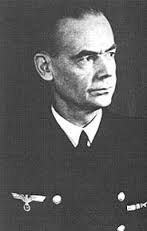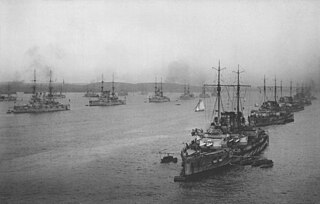
The Reichsmarine was the name of the German Navy during the Weimar Republic and first two years of Nazi Germany. It was the naval branch of the Reichswehr, existing from 1919 to 1935. In 1935, it became known as the Kriegsmarine, a branch of the Wehrmacht; a change implemented by Adolf Hitler. Many of the administrative and organizational tenets of the Reichsmarine were then carried over into the organization of the Kriegsmarine.
Hermann Bauer was a German naval officer who served as commander of the U-boat forces of the Kaiserliche Marine during World War I. In addition to his World War I career, Bauer is well known as the author of the book Das Unterseeboot, a treatise on the design and operation of U-boats, which was later translated into English by Hyman G. Rickover. Rickover's translation became a basic text for the US submarine service.

Hans-Rudolf Rösing was a German U-boat commander in World War II and later served in the Bundesmarine of the Federal Republic of Germany. He was a recipient of the Knight's Cross of the Iron Cross, of Nazi Germany.

Conrad Albrecht was a German admiral during World War II.

SMS Prinz Adalbert was an armored cruiser built in the early 1900s for the German Kaiserliche Marine, named after Prince Adalbert of Prussia, former Commander-in-Chief of the Prussian Navy. She was the lead ship of her class, which included a second ship, Friedrich Carl. Prinz Adalbert was built at the Imperial Dockyard in Kiel. Her keel was laid in April 1900, and she was launched in June 1901. Her completion in January 1904 had been delayed by a surplus of construction projects at the Imperial Dockyard. She was armed with a main battery of four 21 cm (8.3 in) guns, a significant improvement over the previous armored cruiser, Prinz Heinrich, which carried only two 24 cm (9.4 in) guns. The ship was capable of a top speed of 20 kn.

Theodor Burchardi was an Admiral with the Kriegsmarine during World War II and recipient of the Knight's Cross of the Iron Cross with Oak Leaves of Nazi Germany. He was responsible for organising the evacuation of 2 million people from Courland and Eastern Prussia at the end of World War II in Operation Hannibal and the Evacuation of East Prussia.

Rolf Hans Wilhelm Karl Carls was a high-ranking German admiral during World War II. He was a recipient of the Knight's Cross of the Iron Cross of Nazi Germany.

Kurt Fricke was an Admiral with the Kriegsmarine (navy) of Nazi Germany during World War II and a recipient of the Knight's Cross of the Iron Cross.

Hans-Jürgen "Hansjürgen" Rudolf Reinicke was a Kapitän zur See, commander of heavy cruiser Prinz Eugen, in Nazi Germany's Kriegsmarine during the Second World War and recipient of the Knight's Cross of the Iron Cross.

Kurt-Caesar Hoffmann was a senior naval commander in the German Navy (Kriegsmarine) during World War II, who commanded the battleship Scharnhorst. He was a recipient of the Knight's Cross of the Iron Cross.

Hubert Schmundt was a German admiral during World War II. He was a recipient of the Knight's Cross of the Iron Cross of Nazi Germany.

Eberhard Godt was a German naval officer who served in both World War I and World War II, eventually rising to command the Kriegsmarine's U-boat operations.

The II Battle Squadron was a unit of the German High Seas Fleet before and during World War I. The squadron saw action throughout the war, including the Battle of Jutland on 31 May – 1 June 1916, where it formed the rear of the German line.
Naval regions and districts were the official shore establishment of Nazi Germany's Kriegsmarine during World War II. The Kriegsmarine shore establishment was divided into four senior regional commands, who were in turn subordinated to the operational Navy Group commanders who commanded all sea and shore naval forces within a particular geographical region. Within each naval region were several subordinate naval districts who were responsible for all navy shore activities within their area of responsibility, most significantly were the various German ports of occupied Europe.
A type commander in the Kriegsmarine was a permanently assigned administrative officer in the organization of the Kriegsmarine which oversaw the development, deployment, and in some cases operational activities of the various classes of German naval vessels. Due to cross jurisdiction with the Navy group commanders, who tactically commanded all vessels at sea, some type commanders were little more than ceremonial officers who held a title with little authority. Others, such as Karl Dönitz who commanded the German U-boat force, exercised near total independence and held enormous authority, both operationally and administrative.

Erhard Maertens or Eberhard Maertens was a German Vizeadmiral of the Kriegsmarine during World War II. From 16 June 1941 to 5 May 1943, he was Chief of Office of Naval Intelligence, Naval War Command in the Oberkommando der Marine. Maertens was known for underestimating British intelligence, and specifically, overrating the security of the Naval Enigma cipher machine. In 1941, he held a naval enquiry into the strength of Naval Enigma security after the capture of U-boat U-570, and attributed all the suspicious losses in U-boats at the time to the British Huff-Duff. In the second enquiry, ordered by the Commander-in-Chief of the Navy Karl Dönitz, in May 1943, he investigated a number of areas, which exculpated Enigma security in the end, for the second time, incorrectly blaming British 9.7 centimetre centimetric radar for the massive losses in U-boats by mid 1943.
Fritz Krauss was a German naval officer, most recently a Konteradmiral in the World War II. Between 16 August 1944 – 22 July 1945, Fritz Krauss was Director of Department of Naval Intelligence, specifically 3 SKL/MND IV of the German Navy.
Paul Wever was a German naval officer, Vizeadmiral of the Kriegsmarine during World War II. Paul Wever belonged to the generation of men who were sent to war, twice. Between 1 January 1940 to 21 June 1940 was director of the Department of Navy Message Evaluation, later called (3/SKL) Naval Operations of the Naval War Command. The unit was specifically concerned with Naval Intelligence.

Ludwig Stummel was a German career signals officer with the rank of Konteradmiral, who had a glass eye and a limp and who was in effect, the Chief of Staff of the Naval Warfare department, Naval Communications (4/SKL) of the Kriegsmarine. Stummel was most notable for being the person responsible for the cryptographical security of the Enigma cipher machine and Key M infrastructure security, during World War II. Stummel was replaced at the Kriegsmarine Naval War Command on the 16–17 August 1944 by Fritz Krauss, after becoming ill. Stummel was a fervent Catholic. His faith gave him a moral compass during the latter years of the war. Initially a supporter of Nazis. He became doubtful as the war progressed. He was released from the Kriegsmarine in February 1945.
This is the order of battle of the Imperial German Navy on the outbreak of World War I in August 1914.















